经验模式分解
- 格式:ppt
- 大小:67.00 KB
- 文档页数:78
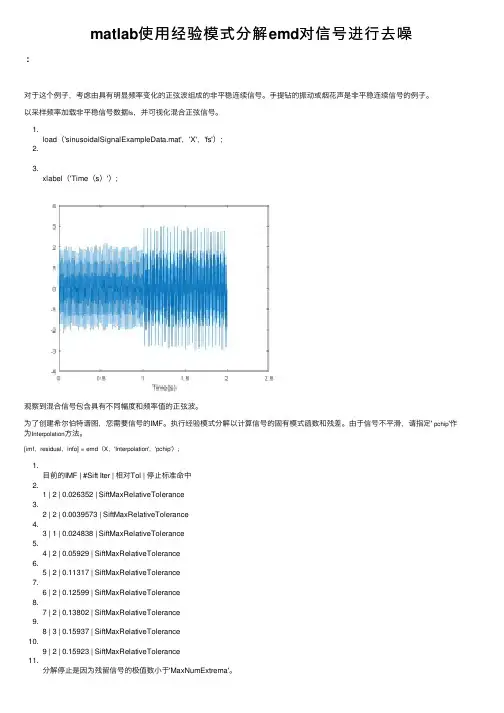
matlab使⽤经验模式分解emd对信号进⾏去噪:对于这个例⼦,考虑由具有明显频率变化的正弦波组成的⾮平稳连续信号。
⼿提钻的振动或烟花声是⾮平稳连续信号的例⼦。
以采样频率加载⾮平稳信号数据fs,并可视化混合正弦信号。
1.load('sinusoidalSignalExampleData.mat','X','fs');2.3.xlabel('Time(s)');观察到混合信号包含具有不同幅度和频率值的正弦波。
为了创建希尔伯特谱图,您需要信号的IMF。
执⾏经验模式分解以计算信号的固有模式函数和残差。
由于信号不平滑,请指定' pchip'作为Interpolation⽅法。
[imf,residual,info] = emd(X,'Interpolation','pchip');1.⽬前的IMF | #Sift Iter | 相对Tol | 停⽌标准命中2.1 |2 | 0.026352 | SiftMaxRelativeTolerance3.2 | 2 | 0.0039573 | SiftMaxRelativeTolerance4.3 | 1 | 0.024838 | SiftMaxRelativeTolerance5.4 | 2 | 0.05929 | SiftMaxRelativeTolerance6.5 | 2 | 0.11317 | SiftMaxRelativeTolerance7.6 | 2 | 0.12599 | SiftMaxRelativeTolerance8.7 | 2 | 0.13802 | SiftMaxRelativeTolerance9.8 | 3 | 0.15937 | SiftMaxRelativeTolerance10.9 | 2 | 0.15923 | SiftMaxRelativeTolerance11.分解停⽌是因为残留信号的极值数⼩于'MaxNumExtrema'。
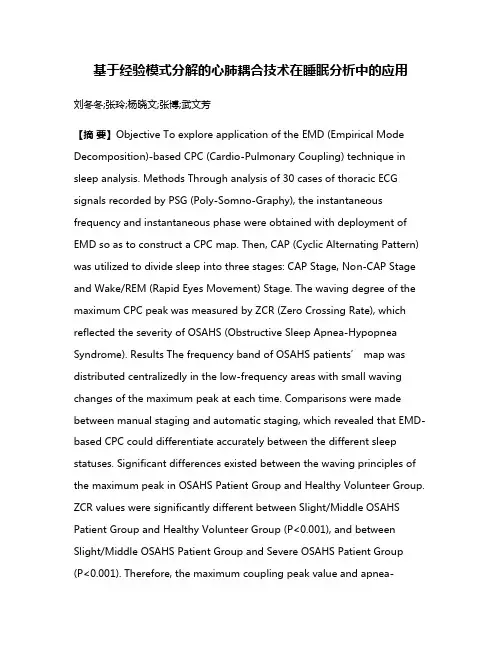
基于经验模式分解的心肺耦合技术在睡眠分析中的应用刘冬冬;张玲;杨晓文;张博;武文芳【摘要】Objective To explore application of the EMD (Empirical Mode Decomposition)-based CPC (Cardio-Pulmonary Coupling) technique in sleep analysis. Methods Through analysis of 30 cases of thoracic ECG signals recorded by PSG (Poly-Somno-Graphy), the instantaneous frequency and instantaneous phase were obtained with deployment of EMD so as to construct a CPC map. Then, CAP (Cyclic Alternating Pattern) was utilized to divide sleep into three stages: CAP Stage, Non-CAP Stage and Wake/REM (Rapid Eyes Movement) Stage. The waving degree of the maximum CPC peak was measured by ZCR (Zero Crossing Rate), which reflected the severity of OSAHS (Obstructive Sleep Apnea-Hypopnea Syndrome). Results The frequency band of OSAHS patients’ map was distributed centralizedly in the low-frequency areas with small waving changes of the maximum peak at each time. Comparisons were made between manual staging and automatic staging, which revealed that EMD-based CPC could differentiate accurately between the different sleep statuses. Significant differences existed between the waving principles of the maximum peak in OSAHS Patient Group and Healthy Volunteer Group. ZCR values were significantly different between Slight/Middle OSAHS Patient Group and Healthy Volunteer Group (P<0.001), and between Slight/Middle OSAHS Patient Group and Severe OSAHS Patient Group (P<0.001). Therefore, the maximum coupling peak value and apnea-hypopnea Index could be used as indexes to identify the different severity of OSAHS patients. Moreover, strong negative correlation was seen between the two indexes (r=-0.77,P=5.8×10-18).Conclusion Combinationof EMD and the CPC technique had proven its easy-to-operate features in data acquisition so as to provide reliable micro-structure and disorder information of sleep, which had huge development potentials in the ifelds of wearable health management and clinically-aided diagnosis.%目的:探讨基于经验模式分解的心肺耦合技术在睡眠分析中的应用。
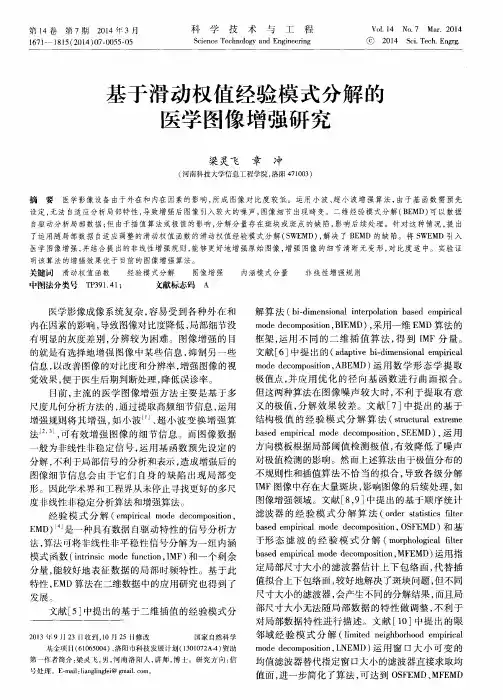
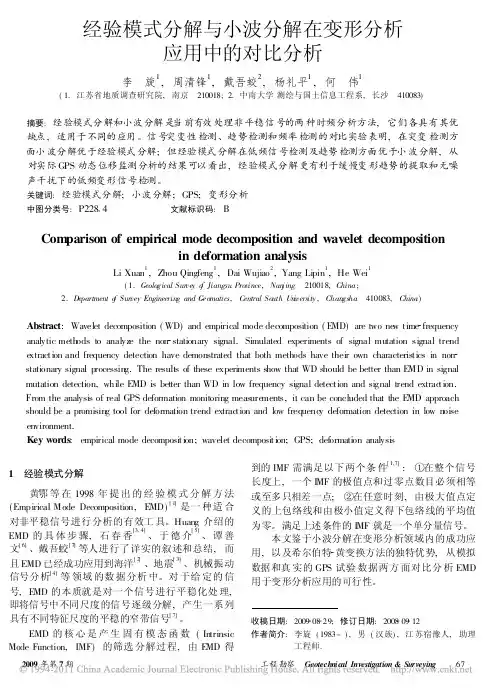
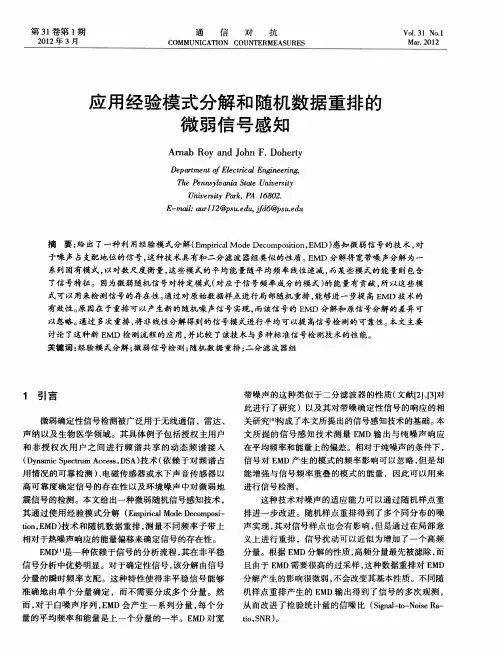
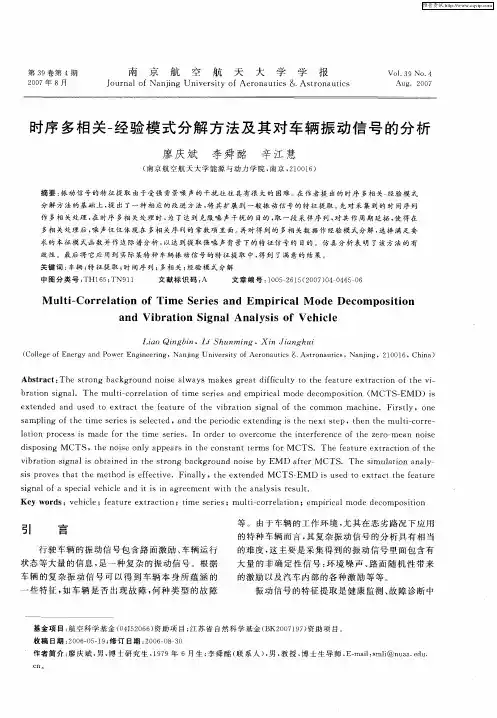
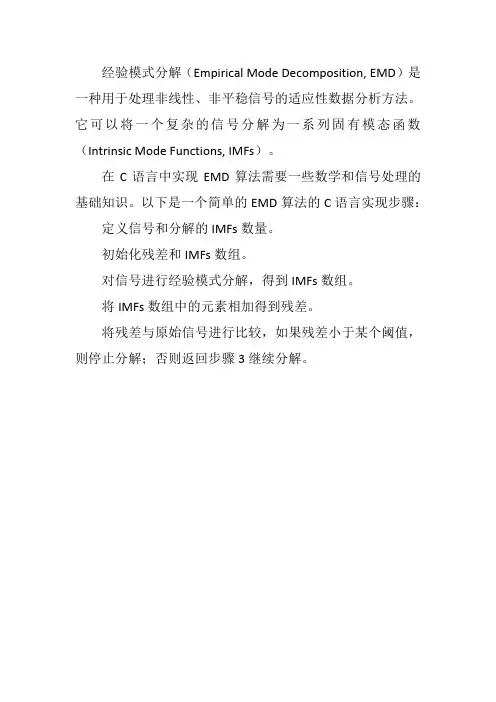
经验模式分解(Empirical Mode Decomposition, EMD)是一种用于处理非线性、非平稳信号的适应性数据分析方法。
它可以将一个复杂的信号分解为一系列固有模态函数(Intrinsic Mode Functions, IMFs)。
在C语言中实现EMD算法需要一些数学和信号处理的基础知识。
以下是一个简单的EMD算法的C语言实现步骤:定义信号和分解的IMFs数量。
初始化残差和IMFs数组。
对信号进行经验模式分解,得到IMFs数组。
将IMFs数组中的元素相加得到残差。
将残差与原始信号进行比较,如果残差小于某个阈值,则停止分解;否则返回步骤3继续分解。
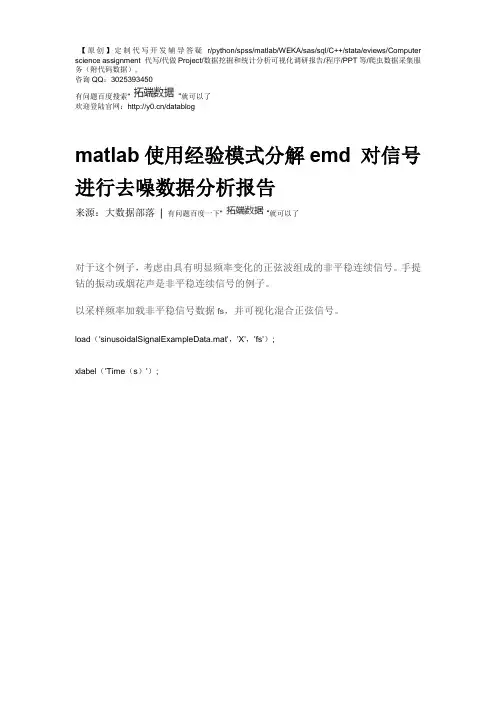
咨询QQ:3025393450有问题百度搜索“”就可以了欢迎登陆官网:/datablogmatlab使用经验模式分解emd 对信号进行去噪数据分析报告来源:大数据部落| 有问题百度一下“”就可以了对于这个例子,考虑由具有明显频率变化的正弦波组成的非平稳连续信号。
手提钻的振动或烟花声是非平稳连续信号的例子。
以采样频率加载非平稳信号数据fs,并可视化混合正弦信号。
load('sinusoidalSignalExampleData.mat','X','fs');xlabel('Time(s)');咨询QQ:3025393450有问题百度搜索“”就可以了欢迎登陆官网:/datablog观察到混合信号包含具有不同幅度和频率值的正弦波。
为了创建希尔伯特谱图,您需要信号的IMF。
执行经验模式分解以计算信号的固有模式函数和残差。
由于信号不平滑,请指定' pchip'作为Interpolation方法。
[imf,residual,info] = emd(X,'Interpolation','pchip');目前的IMF | #Sift Iter | 相对Tol | 停止标准命中1 |2 | 0.026352 | SiftMaxRelativeTolerance2 | 2 | 0.0039573 | SiftMaxRelativeTolerance3 | 1 | 0.024838 | SiftMaxRelativeTolerance4 | 2 | 0.05929 | SiftMaxRelativeTolerance5 | 2 | 0.11317 | SiftMaxRelativeTolerance6 | 2 | 0.12599 | SiftMaxRelativeTolerance7 | 2 | 0.13802 | SiftMaxRelativeTolerance咨询QQ:3025393450有问题百度搜索“”就可以了欢迎登陆官网:/datablog8 | 3 | 0.15937 | SiftMaxRelativeTolerance9 | 2 | 0.15923 | SiftMaxRelativeTolerance分解停止是因为残留信号的极值数小于'MaxNumExtrema'。
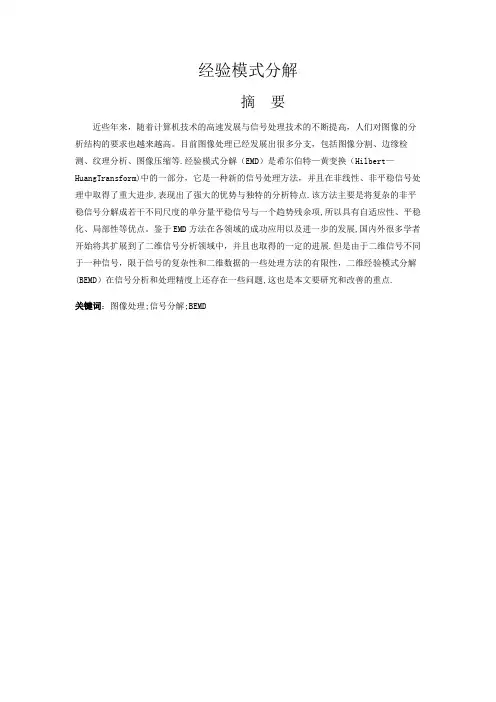
经验模式分解摘要近些年来,随着计算机技术的高速发展与信号处理技术的不断提高,人们对图像的分析结构的要求也越来越高。
目前图像处理已经发展出很多分支,包括图像分割、边缘检测、纹理分析、图像压缩等.经验模式分解(EMD)是希尔伯特—黄变换(Hilbert—HuangTransform)中的一部分,它是一种新的信号处理方法,并且在非线性、非平稳信号处理中取得了重大进步,表现出了强大的优势与独特的分析特点.该方法主要是将复杂的非平稳信号分解成若干不同尺度的单分量平稳信号与一个趋势残余项,所以具有自适应性、平稳化、局部性等优点。
鉴于EMD方法在各领域的成功应用以及进一步的发展,国内外很多学者开始将其扩展到了二维信号分析领域中,并且也取得的一定的进展.但是由于二维信号不同于一种信号,限于信号的复杂性和二维数据的一些处理方法的有限性,二维经验模式分解(BEMD)在信号分析和处理精度上还存在一些问题,这也是本文要研究和改善的重点.关键词:图像处理;信号分解;BEMDAbstractIn recent years,with the rapid development of computer technology and the continuous improvement of signal processing technology,the demand for the analysis structure of the image is becoming more and more high. At present, many branches have been developed in image processing, including image segmentation, edge detection,texture analysis, image compression and so on。
Empirical mode decomposition (EMD) is a part of Hilbert Huang transform (Hilbert—HuangTransform). It is a new signal processing method, and has made significant progress in nonlinear and non—stationary signal processing, showing strong advantages and unique analysis points。
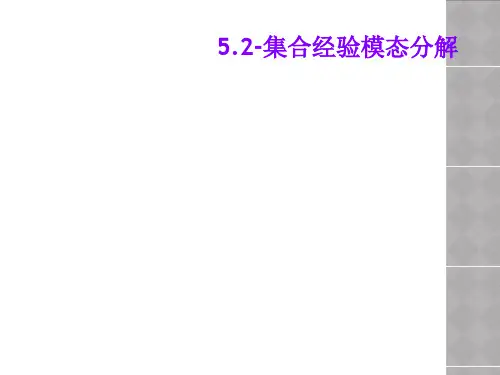
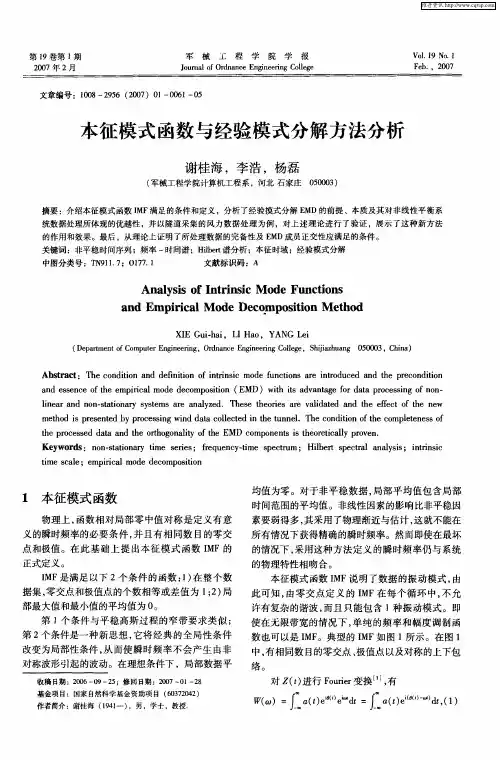
咨询QQ:3025393450有问题到百度搜索“大数据部落”就可以了欢迎登陆官网:/datablogmatlab使用经验模式分解emd 对信号进行去噪数据对于这个例子,考虑由具有明显频率变化的正弦波组成的非平稳连续信号。
手提钻的振动和烟花声是非平稳连续信号的例子。
以采样频率加载非平稳信号数据fs,并可视化混合正弦信号。
load('sinusoidalSignalExampleData.mat','X','fs')t = (0:length(X)-1)/fs;plot(t,X)xlabel('Time(s)')咨询QQ:3025393450有问题到百度搜索“大数据部落”就可以了欢迎登陆官网:/datablog混合信号包含具有不同幅度和频率值的正弦波。
要创建希尔伯特谱图,您需要信号的固有模式函数(IMF)。
执行经验模式分解以计算信号的IMF和残差。
由于信号不平滑,请指定' pchip'作为Interpolation方法。
[imf,residual,info] = emd(X,'Interpolation','pchip');Current IMF | #Sift Iter | Relative Tol | Stop Criterion Hit1 |2 | 0.026352 | SiftMaxRelativeTolerance2 | 2 | 0.0039573 | SiftMaxRelativeTolerance3 | 1 | 0.024838 | SiftMaxRelativeTolerance4 | 2 | 0.05929 | SiftMaxRelativeTolerance5 | 2 | 0.11317 | SiftMaxRelativeTolerance6 | 2 | 0.12599 | SiftMaxRelativeTolerance7 | 2 | 0.13802 | SiftMaxRelativeTolerance咨询QQ:3025393450有问题到百度搜索“大数据部落”就可以了欢迎登陆官网:/datablog8 | 3 | 0.15937 | SiftMaxRelativeTolerance9 | 2 | 0.15923 | SiftMaxRelativeToleranceThe decomposition stopped because the number of extrema of the residual signal is less than 'MaxNumExtrema'.在命令窗口中生成的表格指示每个生成的IMF的筛选迭代次数,相对容差和筛选停止标准。
基于二维经验模式分解的重力资料多尺度分析李芳;王林飞;何辉【摘要】重力资料是从地表到深部所有密度不均匀体引起的重力效应的叠加.针对不同的工作任务,需要利用不同尺度的重力资料进行研究.二维经验模式分解能够自适应地对非线性、非平稳信号实现多尺度分解.文章研究将二维经验模式分解应用于重力资料的多尺度分析,对重力数据进行二维经验模式分解以得到各级固有模态函数和剩余分量,利用径向对数功率谱分析方法估计各级模态函数所反映的地下场源的近似深度,定性地解释不同深度下的场源产生的异常,较好地揭示场源赋存的地质信息.模型数据和实际数据的测试佐证了该方法技术的可行性.【期刊名称】《物探与化探》【年(卷),期】2018(042)004【总页数】7页(P731-737)【关键词】重力资料;二维经验模式分解;多尺度分析;径向对数功率谱【作者】李芳;王林飞;何辉【作者单位】中国国土资源航空物探遥感中心,北京 100083;中国国土资源航空物探遥感中心,北京 100083;中国国土资源航空物探遥感中心,北京 100083【正文语种】中文【中图分类】P6310 引言重力方法在地球结构及地质构造研究、资源勘探及工程勘察等方面发挥了巨大的作用[1]。
实测重力资料包含了从地表到深部所有密度不均匀体引起的重力效应,信息量十分巨大。
因此针对不同的工作任务,需要从重力资料中分离出研究目标所产生的重力异常[2],比如需要利用实测的重力数据进行某矿区特定地质体的反演解释,则必须首先从总异常中分离出单纯由这个地质体引起的异常,然后利用此异常进行反演解释。
对重力资料进行合理的多尺度分析是顺利完成诸如重力场特征分析、断裂构造划分与分析、圈闭岩体、分析矿产有利区域等系列地质任务的保证[3-4]。
目前,对重力资料进行不同尺度分离的方法很多,比如向上延拓法[5]、补偿圆滑滤波法[6]、非线性滤波法[7]、小波变换法[8]等。
上述方法在处理重力资料时存在各自的优势及缺陷,一个共性的弊端是几乎所有的处理方法均存在预先处理参数设定的问题,这往往导致处理后的重力数据仍旧存在浅源短波长信息和深源长波长信息的混杂,后续工作无法给出解释工作的可信度。
经验模式分解集团文件版本号:(M928-T898-M248-WU2669-I2896-DQ586-M1988)经验模式分解摘要近些年来,随着计算机技术的高速发展与信号处理技术的不断提高,人们对图像的分析结构的要求也越来越高。
目前图像处理已经发展出很多分支,包括图像分割、边缘检测、纹理分析、图像压缩等。
经验模式分解(EMD)是希尔伯特-黄变换(Hilbert-HuangTransform)中的一部分,它是一种新的信号处理方法,并且在非线性、非平稳信号处理中取得了重大进步,表现出了强大的优势与独特的分析特点。
该方法主要是将复杂的非平稳信号分解成若干不同尺度的单分量平稳信号与一个趋势残余项,所以具有自适应性、平稳化、局部性等优点。
鉴于EMD方法在各领域的成功应用以及进一步的发展,国内外很多学者开始将其扩展到了二维信号分析领域中,并且也取得的一定的进展。
但是由于二维信号不同于一种信号,限于信号的复杂性和二维数据的一些处理方法的有限性,二维经验模式分解(BEMD)在信号分析和处理精度上还存在一些问题,这也是本文要研究和改善的重点。
关键词:图像处理;信号分解;BEMDAbstractIn recent years, with the rapid development of computer technology and the continuous improvement of signal processing technology, the demand for the analysis structure of the image is becoming more and more high. At present, many branches have been developed in image processing, including image segmentation, edge detection, texture analysis, image compression and so on. Empirical mode decomposition (EMD) is a part of Hilbert Huang transform (Hilbert-HuangTransform). It is a new signal processing method, and has made significant progress in nonlinear and non-stationary signal processing,showing strong advantages and unique analysis points. This method mainly decomposes the complex non-stationary signals into several single scale stationary signals with different scales and a trend residual term, so it has the advantages of adaptability, stationarity and locality. In view of the successful application and further development of EMD method in many fields, many scholars at home and abroad have expanded it to the two-dimensional signal analysis field, and have made some progress. However, because two dimensional signal is different from one signal, it is limited to the complexity of signal and the processing methods of two-dimensional data. Two-dimensional empirical mode decomposition (BEMD) still has some problems in the accuracy of signal analysis and processing, which is also the important point of research and improvement in this paper.Key words: image processing; signal decomposition; BEMD目录第一章概况随着计算机技术的不断发展和其应用领域的不断扩展,数字图像处理技术得到了迅猛的发展,涉及信息科学、计算机科学、数学、物理学以及生物学等学科,因此数理及相关的边缘学科对图像处理科学的发展有越来越大的影响。
HHT变换1.1简介传统的信号处理方法,如傅立叶分析是一种纯频域的分析方法。
它用频率不同的各复正弦分量的叠加来拟合原函数,也即用()ωF来分辨()ωf。
而()ωF在有限频域上的信息不足以确定在任意小范围内的函数()ωf,特别是非平稳信号在时间轴上的任何突变,其频谱将散布在整个频率轴上。
而且,非平稳动态信号的统计特性与时间有关,对非平稳信号的处理需要进行时频分析,希望得到时域和频域中非平稳信号的全貌和局域化结果。
在傅立叶变换中,人们若想得到信号的时域信息,就得不到频域信息。
反之亦然。
后来出现的小波(Wavelet)变换通过一种可伸缩和平移的小波对信号变换,从而达到时频局域化分析的目的。
但这种变换实际上没有完全摆脱傅立叶变换的局限,它是一种窗口可调的傅立叶变换,其窗内的信号必须是平稳的。
另外,小波变换是非适应性的,小波基一旦选定,在整个信号分析过程中就只能使用这一个小波基了。
HHT(Hilbert-Huang Transform)技术是(1998年由NASA的Norden E Huang 等提出的新的信号处理方法。
该方法适用于非线性非平稳的信号分析,被认为是近年来对以傅立叶变换为基础的线性和稳态谱分析的一个重大突破。
目前HHT 技术已用于地球物理学和生物医学等领域的研究,并取得了较好的结果。
存在的问题尽管HHT技术在处理非线性、非稳态信号方面有很大的优势,但是这个方法本身还是有许多的问题有待进一步研究。
正如Huang 在文章中指出的那样,对于这种新的信号处理方法,其基的完备性还需要严密的证明。
另外,在做Hilbert 变换时出现的边界效应也需要更好的方法来解决。
但是,HHT 技术中最严重,也是现今研究的最多的是EMD 分解中的包络过程。
从对EMD 分解方法的介绍可以看出,包络线的构造影响着整个分解的结果,也决定了后面的Hilbert 变换。
Huang 采用的三次样条插值来拟和包络线。
在实际应用中,发现这样做会产生严重的边界效应,污染了原始数据。
c语言经验模式分解经验模式分解是指通过分析程序员在编写特定语言的代码时所经历的各种经验和行为模式,以及解决问题时采取的具体方法和技巧。
在C语言编程中,经验模式分解可以帮助程序员更好地理解和应用C语言的特性和规范,提高代码的质量和效率。
下面将介绍几种常见的经验模式分解的实例。
1. 使用标准库函数:C语言提供了丰富的标准库函数,包括字符串处理、数学计算、内存管理等多个方面。
在编程过程中,充分利用这些标准库函数可以减少代码量,提高编程效率。
例如,我们需要在字符串中查找某个子串的位置,可以使用`strstr()`函数来实现,而不需要手动编写查找算法。
通过对标准库函数的熟悉和灵活运用,可以极大地减少开发时间和调试工作。
2. 使用预处理命令:C语言的预处理命令可以在编译之前对源代码进行处理,可以在程序运行时根据需要进行条件编译、宏定义等操作。
预处理命令的灵活运用可以提高程序的可读性和可维护性。
比如,我们可以使用条件编译命令`#ifdef`和`#endif`来根据不同的编译条件对代码进行选择性编译,从而提高程序的可移植性。
3. 使用函数和结构体:C语言是一种面向过程的编程语言,但也支持函数和结构体等面向对象的编程技术。
在编写复杂的程序时,通过合理地使用函数和结构体,可以将代码模块化,使得代码结构更清晰、可读性更好。
例如,将一些常用的功能封装成函数,可以减少代码冗余,提高代码的重用性。
另外,使用结构体可以将相关的数据集中管理,减少全局变量的使用。
4. 错误处理和异常处理:编写健壮的代码需要考虑错误处理和异常处理。
在C语言中,我们通常使用返回值来表示函数执行的状态,当函数执行失败时会返回特定的错误码,我们可以根据这些错误码来判断程序行为。
另外,C语言也支持使用`setjmp()`和`longjmp()`函数来实现错误和异常的处理。
这些错误处理和异常处理的技巧可以保护程序的稳定性,提高程序的可靠性。
5. 良好的代码注释和命名规范:良好的代码注释和命名规范对于代码的可读性和可维护性非常重要。